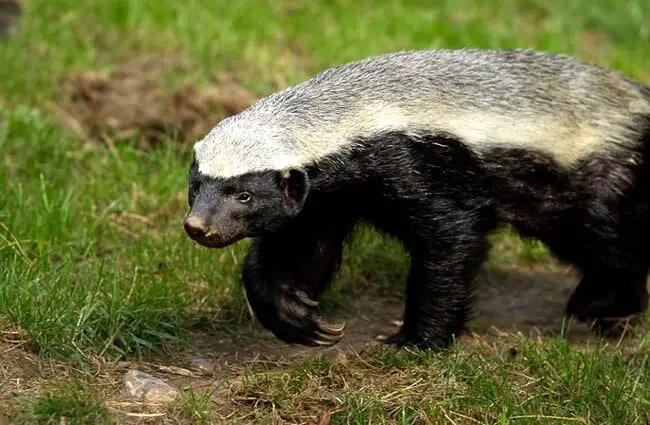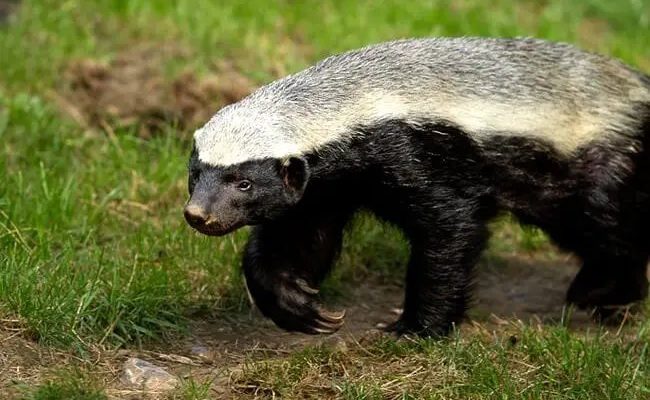
In this article, we’ll explore ten animals that are similar to the honey badger. So, if you’ve ever wondered what other critters have that same spirit, this is for you! Don’t worry; we’ll break it down so that you can easily tell them apart. It might feel like diving into a wild nature documentary, but I promise to keep it engaging and simple. So grab a cup of coffee, and let’s get started!
1. American Badger
The American badger, like its honey counterpart, is known for being stubborn and tenacious. These critters are typically found in North America and love to dig. They have short, strong limbs and a sleek body covered in gray fur with black stripes on their face.
What sets the American badger apart is its habitat preference. While honey badgers roam the savannas of Africa, American badgers thrive in open grasslands and deserts. They are also more social than honey badgers, often seen in small family units. So, while they share the name “badger,” you’ll notice differences in size, behavior, and habitat.
2. European Badger
Similar in name and behavior, the European badger is another close relative of the honey badger. These guys are found throughout Europe and are much heavier than American badgers. They have a distinctive black-and-white striped face too!
One of the key differences is their diet. European badgers are more omnivorous, feasting not only on small animals and insects but also fruits and nuts. If you spot a badger digging around, it might be foraging for some tasty treats instead of just hunting. Their social structure—living in groups called clans—also sets them apart from the more solitary honey badger.
3. Ferret
At first glance, you might not think of ferrets as tough, but these playful little creatures have a feisty side. Ferrets are domesticated members of the weasel family and share physical traits with honey badgers, like long bodies and short legs.
The main difference? Ferrets are usually found in homes as pets, rather than in the wild. They have a playful personality but can also display a streak of independence, much like a honey badger. If you catch one in a mood, they might surprise you with their energy and curiosity!
4. Wolverine
Wolverines are the ultimate survivors of the animal world. With stocky bodies and powerful limbs, these larger-than-life creatures can take down prey much bigger than themselves—just like honey badgers. They’re often found in the northern regions, thriving in snowy environments.
Wolverines differ from honey badgers in that they tend to be more solitary and territorial. They have a reputation for being aggressive and fiercely protect their food supply. Their thick fur keeps them warm during the harsh winters, which is quite different from the African climate where honey badgers roam.
5. Striped Skunk
Striped skunks might seem like an odd comparison, but there’s more to these little guys than their notorious spray. They share a similar size and shape with honey badgers, and both possess a bit of a “don’t mess with me” attitude.
However, their primary defense mechanism is quite different. While honey badgers use sheer aggression, skunks rely on a powerful spray to ward off predators. If you ever find yourself up close to a skunk, you’ll understand the importance of keeping your distance!
6. European Polecat
The European polecat is another cousin in the weasel family. With a sleek body, dark fur, and a bit of a mischievous attitude, they share some common traits with honey badgers. Both species have a knack for being resourceful hunters.
Yet, polecats are a bit shyer in nature. They prefer to live in dense cover, like forests and grasslands, and often hunt small mammals, birds, and even amphibians. If you encounter one, don’t expect the same boldness you’d see in a honey badger.
7. Meerkat
Meerkats are often seen standing up on their hind legs, ready to take on whatever the wild throws at them. While they lack the honey badger’s ferocity, they do share a social structure that’s fascinating.
These small mammals work as a team, hunting for food and keeping an eye out for predators. Unlike honey badgers, meerkats rely on their group dynamics, using teamwork to stay safe. They have a lot of personality and can be quite entertaining to watch!
8. Raccoon
Raccoons are often known for their cleverness, resourcefulness, and adaptability. They have similar foraging habits to honey badgers and are comfortable in urban settings as much as in the wild. With their masked faces and dexterous paws, they can often get into trouble searching for food.
However, raccoons are much smaller and tend to be more playful. They rely on their intelligence and ability to manipulate objects, while honey badgers rely on brute strength and ferocity. It’s like comparing a sneaky magician to an intimidating bouncer!
9. Tasmanian Devil
Tasmanian devils are famous for their ferocity and tenacity, just like honey badgers. With strong jaws and a shrill, terrifying screech, they can intimidate other animals. Found only in Tasmania, these creatures are a bit larger than honey badgers and are nocturnal.
While their diets overlap, Tasmanian devils are primarily scavengers, feeding on carrion. This sets them apart from honey badgers, who actively hunt for their food. When it comes to aggression, both can hold their own, but the Tasmanian devil has a unique edge due to its scavenging lifestyle.
10. Kinkajou
Kinkajous are also known as “honey bears,” and they do share a love for sweet treats, especially honey. These tree-dwelling mammals are native to Central and South America and have a playful, curious personality.
Unlike honey badgers, kinkajous are much more gentle and avoid confrontation when possible. Their long, prehensile tails help them navigate through the treetops, which is a stark contrast to the ground-dwelling lifestyle of honey badgers. If you picture the honey badger as a fierce warrior, think of the kinkajou as the delightful performer of the jungle!
So there you have it—ten animals that share traits with the infamous honey badger, each with their own unique lifestyles and characteristics. Whether it’s the tenacity of wolverines or the playful charm of kinkajous, the animal kingdom is full of surprises.
Next time you hear someone mention the honey badger, you can drop some knowledge about its tough relatives. And remember, while these animals might be similar in some ways, each has its own story to tell. Nature is a wild place, and there’s always something new to learn about the creatures that share our world! Keep exploring and discovering; you never know what fascinating connections you might find!

